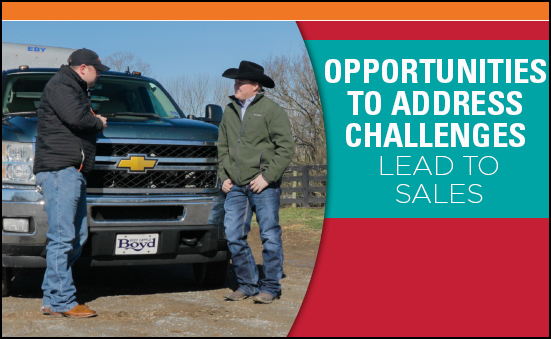For some on the BioZyme sales team, they take the relationship approach to getting products in front of customers. It is more about being problem solvers or helping the potential customer reach their production goals with a nutrition program, than it is “selling” a product.
Brett Tostenson, ASM who represents South Dakota and Eastern North Dakota, said he does extensive homework about a potential customer’s production goals, both commercial and seedstock, before he ever makes contact or sets foot on his or her ranch. With the use of the Internet and state-wide ag publications, there is typically a plethora of information about the larger cow-calf producers he calls on.
“I’m a huge proponent of connection-based selling to help them meet their needs. I look at the birthdates and sire groups in their sale catalogs, see if they have a ranch website or Facebook page, and Google to see if there is information about them, where they market their cattle. This helps me have a plan before I ever meet them,” Tostenson said.
He adds that is it is imperative to be genuine in the conversation, and with knowing background about their operation or having a mutual contact, it shows that you have an interest, and you are not just another cold call salesperson.
Once he knows about their operation, he will set up a time to stop by to look at their cattle, which he enjoys doing. Then, after he’s seen their cattle and had a good conversation, he’ll listen to any needs the producer might have like poor breed-backs, retained placentas or low conception rates. That is when he tells them about the reproductive mineral he uses on his own herd, VitaFerm® Concept•Aid®. His closing statement is strong:
“I don’t try to sell something I would not use on my own cattle.”
Once that trust is established and the producer decides to try the product, Tostenson will put him or her in touch with a dealer. He does follow up to make sure the dealer and the product is meeting expectations. And, he said it is important to be visible at their sale, but just to say hello, and not to talk shop on their big pay day.
The Consultant
Similar to Tostenson, Ty McGuire, who represents Michigan, Western Ohio and Kentucky, said he too likes to help potential and current customers meet their operation goals. He likes to consider himself as more of a consultant rather than a salesperson.
“I want them to know that I am looking out for them, and they can confide in me for answers whether it’s about nutrition, A.I. protocols or anything. I am a straight shooter, and that helps gain their trust and get the sale,” McGuire said.
Typically, on an initial visit, he will leave them with some beneficial literature that might include the sale report from a local livestock auction market, along with some BioZyme product information and his business card.
He agrees that sales books are a great way to learn about operations, and you can tell a lot about calving times, calving windows, sire groups and just about the people from the contents of the sale book. He said his initial face-to-face meetings can last from 20 minutes to an hour, and you can tell how much a person will open up and trust another in a short amount of time. Once he has their trust, he likes to talk about Amaferm®.
“I will bend over backwards for a potential customer to get the Amaferm advantage into their livestock. We have great products for every species and every situation, and I want them to know I will help them meet their goals, not only with nutrition but in other areas, as well,” McGuire said.
Do your homework. Build the relationship. Gain the trust. Sometimes selling isn’t even about selling as much as it is helping a fellow producer meet his or her production goals. Relationship selling is all about helping others. And that is care that comes full circle.
